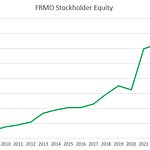Listen to the Special Situation Investing Podcast on Fountain or wherever you listen.
Welcome to Episode 58 of Special Situation Investing.
Let’s begin today’s episode with a quote from Doomberg, the anonymous, green chicken whose Substack has taken the finance world by storm. When asked whether he’s more bullish on oil or natural gas, he said the following:
I would say US domestic natural gas…[because] it has two sources of arbitrage, oil is more expensive than natural gas on an energy content basis and [natural gas] is more expensive in Europe than it is [in the US]. And both of those serve to put a bid under US natural gas. And since natural gas is used for three really important things, heating, producing electricity and creating chemicals, the price elasticity of demand, which will set the marginal price, will be paid by the industry that has the highest potential to afford it and its always better to have three bidders than one.
In one of the green chicken’s Substack articles titled A Serious Proposal on US Energy, Doomberg further supports his argument by claiming natural gas should be foundational to any rational solution to the energy shortage the US, and the world, seems destined to face. And as a plus, since power produced with natural gas creates less than half the carbon emissions as power produced with coal, simply phasing out coal for natural gas would materially reduce global carbon emissions. To the rational mind, natural gas seems to be a no-brainer.
For these reasons, and others, we believe investments in US natural gas could prove a profitable allocation of capital. One of our favorite companies in this space, PHX Minerals, was introduced on the show back in October. If so inclined, review Episode 48 for background information on this small cap, oil and gas royalty company.
Since October, PHX released the results from their fourth quarter 2022 which ended on 30 September and, more recently, they made additional announcements in a press release on 27 December. Today, we are going to delve into a few updates from these announcements.
Transition to higher quality assets continues
As detailed in our last write-up, PHX is in a transitional phase of selling off its legacy, capital intensive working interests in oil wells and replacing them with higher-margin royalty interests. This process was begun in 2019 and is projected to be nearly 100% complete by the end of 2023. The company stated that:
Both royalty production and royalty reserves reached all-time high levels in the fourth fiscal quarter of 2022. 2023 will prove to be the final year of this formative transition as [they] plan to divest a material portion of the remaining legacy non-operated working interest assets, after which royalty volumes will represent greater than 90% of total corporate volumes and working interest volumes will be virtually immaterial.
The good news on this front was continued with the announcement of the planned divestiture of an additional 257 non-operator working interests. The sale combines two separate agreements with different buyers for a total cash consideration of $10.7 million and the deal is expected to close on 30 January. In addition, jettisoning these working interests will remove $879,000 of aggregate asset retirement obligations from the company’s balance sheet. PHX plans to use the proceeds from these divestitures to acquire more minerals with existing production and line-of-sight development and to repay some of the company’s debt.
At the conclusion of this deal, PHX will have only 564 legacy working interests remaining which equates to a reduction of 75% of the total from when the transition was initiated back in 2019. And as mentioned above, the remaining interests, which will make up only 10% of PHX’s production volumes and reserves, are projected to be sold off by the end of 2023.
The PHX management has executed this transition well and one aspect worth highlighting is that they have divested their working interests in a metered way at a pace no faster than they could reallocate the cash into purchases of royalty interests. This way they have avoided having stranded cash sitting on their balance sheet.
Well positioned to ride the natural gas tailwind
Diving a bit deeper into the details of their purchases, it’s clear the company has stuck to its areas of competence, specifically, royalty interests in the SCOOP, STACK, and Haynesville areas. While the company has interests in both oil and gas, 78% of its fiscal 2022 production volumes were from natural gas. This is part of the company’s long-term strategy, and focus, to position themselves long natural gas which they believe to be the key transition fuel for a sustainable energy future. We would tend to agree.
Low price hedges are rolling off
Another potential tailwind for the company this coming year is the expiration of hedges that were put in place at low prices during the uncertainty of 2020.
Year-to-date, these hedges have been a drag on the company’s earnings as much of its sales were made at prices far below the current price. Consider that the average prices received for natural gas, oil and NGL in the latest quarter were up 5% on an Mcfe basis sequentially to $8.42 and for the fiscal year prices increased 75% to an average of $7.27 per Mcfe. Consequently, hedge losses for the quarter were $7 million and $22 million for the full fiscal year. For the full year approximately 62% of natural gas, 72% of oil production volumes were hedged at average prices of $3.06 and $44.25, respectively. These numbers illustrate the magnitude of this disadvantage but also highlight the potential boost for the company as these hedges are rolled off.
The remaining contracts of these hedges will be rolled off in the next of couple months. Assuming commodity prices similar to those seen in 2022, this should produce significantly higher realized prices and increased cashflows going into 2023.
Long runway of new wells coming online
Another likely avenue of cashflow growth in is an increasing number of wells on which PHX has royalty interests coming in line. In 2022, 300 gross wells were converted to producing. Taking into account the net royalties PHX owns on these wells, the net wells converted was 1.08. This increase in producing wells resulted in a 40% year-over-year rise in the volumes of oil and gas attributed to PHX. Looking ahead to 2022, currently approximately 0.08 net wells are permitted and another 0.22 net wells with permits filed but not yet filed.
As show in the chart below, on average, PHX has converted 230 wells per year for the last three years. This trend is likely to continue as PHX has an inventory of nearly 2000 gross probable well locations available to be converted to active wells. This gives an idea of the number of possible wells that will come online in the future and produce future cashflows.

Streamlined financial reporting
And lastly, in its last quarterly call, PHX announced that it will be shifting its fiscal year from ending 30 Sept to ending 31 December. While note hugely impactful, this change will align PHX with most of the companies in the mineral and royalties sector. This will allow investors and analysts to more easily compare PHX against its peers.
Concluding thoughts
As mentioned in our last article, PHX appears to trade at a discount when compared to its peer group. The table below shows PHX and its peers Kimbell Royalty, Viper Energy, Black Stone Minerals, Texas Pacific Land and Sitio Royalties and lists each company’s valuation on a dollar to net royalty acre (NRA) basis. Clearly the there is a wide range from TPL’s $776,371/NRA down to Black Stone’s $472/NRA. But PHX does rank second cheapest, at $580/NRA, coming in slightly more expensive than BSM, but orders of magnitude cheaper than the rest of its peers.

As we wrap up, below are three charts from PHX’s most recent investors presentation that illustrate its growth over the last three years.
Adjusted EBITDA has grown from its low of $1.3 million in Q3 2020, to $8.4 million in the latest quarter.

Return on capital employed has increased from -6% to 22% over the same period.

And since the company began its strategic shift from working interests, royalty interest production has grown at a CAGR of 23%.

To summarize, the management is continuing to expertly execute its plan to transition to a higher margin business model of royalties vs working interests, the company is positioned to take advantage of natural gas’ growing use case and importance in global energy production, low price hedges are rolling off and a constant stream of new wells are coming online, and the company is adjusting its fiscal year to better align it with its peers.
In conclusion, we still believe that PHX Minerals is currently one of the most compelling investments in the minerals and royalty space.
With that we’ve concluded another episode of Special Situation Investing. We hope the content, as always, was helpful in your own investing journey.
Again, a quick thank you to those of you listening to the show via the Fountain app. We appreciate the support and the sats you are sending our way on that platform. And remember, with Fountain you can get paid in sats yourself for just listening to an hour per day of any podcast.














PHX Minerals continues its transformation (PHX)